
ATLAS Plots on Ecm Dependence of Physics Reach
This page contains plots prepared by ATLAS for the LHC Chamonix 2009 meeting (2-6 February 2009)- Expected Performance of the ATLAS Experiment, Detector, Trigger and Physics
 ("CSC book") CERN-OPEN-2008-020
("CSC book") CERN-OPEN-2008-020
| Yield of Z decays to electron pairs usable for calibration and physics studies, for an integrated luminosity of 50 pb-1. Yield is evaluated with full simulation at 14 TeV, as described in CERN-OPEN-2008-020 and scaled to lower centre-of-mass energies using a fast simulation with simple fiducial and kinematic acceptance cuts. Errors shown on the yield are quite conservative and include a ~15% luminosity uncertainty. To set the scale, it should be possible to inter-calibrate, in 0.2x0.4 eta-phi bins, the EM calorimeter to 0.7% statistical error with 50k well-measured Z to ee decays, with the error scaling approximately as 1/sqrt(N). Systematic errors, arising in particular from the knowledge of the upstream material, will have to be well understood to achieve this goal. For muons, 20k Z to muon-pair decays should be statistically sufficient to test the average muon system momentum scale to better than 1% (systematic uncertainties are expected from alignment, knowledge of the magnetic field and energy loss). A more detailed understanding, and region dependent corrections (B-field, material, alignment), will require much larger statistics. |

|
| Yield of J/psi decays to muon pairs usable for calibration and physics studies, for an integrated luminosity of 50 pb-1. The plot shows the yield within a fiducial acceptance: one muon with pT>6 GeV, the second with pT>4 GeV, and both muons within pseudo-rapidity range +-2.5. An approximate detection efficiency factor of 70% is included. The experimental error is estimated to be 10-20% on the usable yield. J/psi and Upsilon decays to muons and electrons will also be important for early detector understanding, such as particle identification and reconstruction, inter-calibration, material effect and detailed alignment studies. |

|
| Yield of top quarks in selected samples, for an integrated luminosity of 50 pb-1. The expected Tevatron (one experiment) statistics with 8 fb-1 are shown as a comparison benchmark. For the di-lepton ('llbb') analysis, no b-tagging is used, neither for Tevatron, nor for ATLAS. For the semi-leptonic ('l+jets') analysis, a mature Tevatron analysis requiring 1 b-tagged jet is compared to an ATLAS analysis tuned for early data, without b-tagging, but providing a useful S/B ratio. The study was performed by scaling 14 TeV full simulation results to lower Ecm values according to the top-pair production cross-section. |
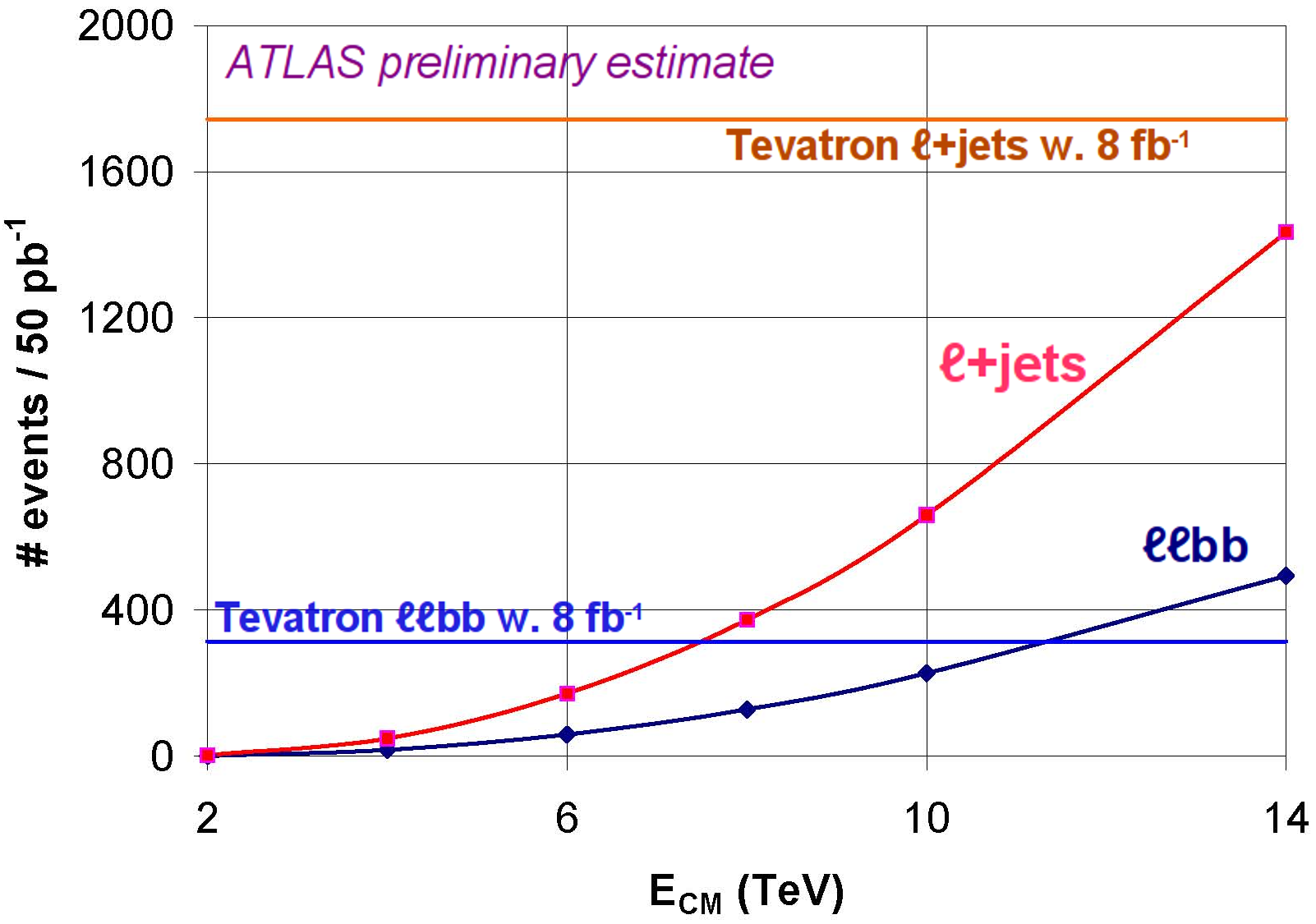
|
| Expected sensitivity to production of a sequential Standard Model-like Z' for Z' masses of 1 and 1.5 TeV, as a function of centre-of-mass energy. The current Tevatron 95% CL lower limit is around 1 TeV. The discovery potential shown corresponds to a signal of at least ten events, which is expected to be somewhat more significant than 5 sigma. Study carried out with a fast simulation (Atlfast), using in addition the reconstruction efficiency (~90%) evaluated with a fuller simulation (Atlfast-II) at 10 TeV. Systematic uncertainties, coming mainly from the alignment of the muon system, are not included. Around 100 pb-1 are needed to obtain discovery potential just beyond the Tevatron limits at 10 TeV centre-of-mass energy. |

|
| Expected sensitivity to production of a sequential Standard Model-like W' for W' masses of 1 and 1.5 TeV, as a function of centre-of-mass energy. The current Tevatron 95% CL lower limit is around 1 TeV. The discovery potential shown corresponds to a signal of at least ten events, which is expected to be rather more than 5 sigma. Study carried out with fast simulation at 10 and 14 TeV and a simple rescaling at lower centre-of-mass energies. Around 20 pb-1 are needed to obtain discovery potential just beyond the Tevatron limits at 10 TeV centre-of-mass energy. This analysis will require a reasonable understanding of backgrounds and detector performance, which will require time to obtain. |
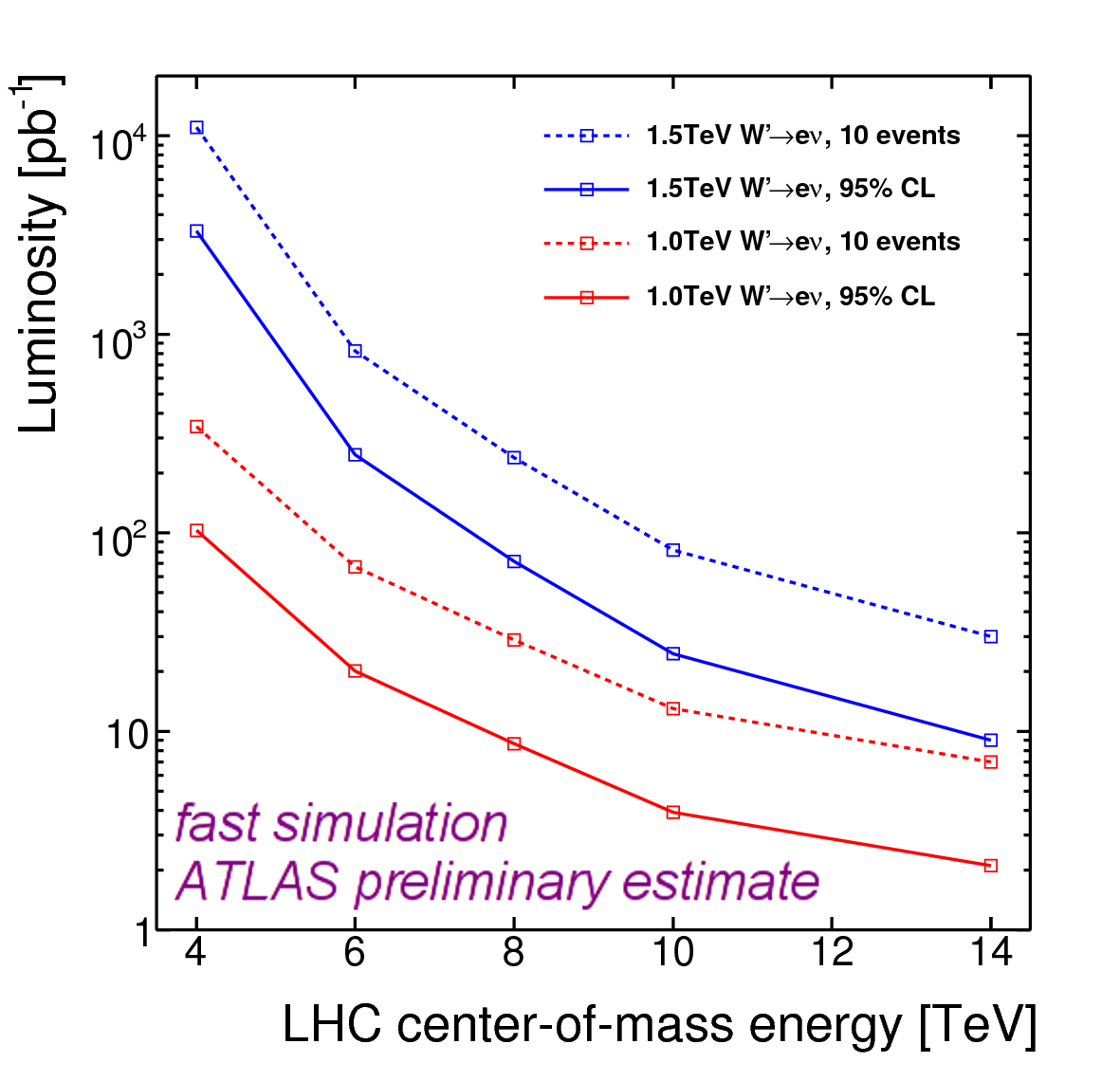
|
| Discovery sensitivity possible for SUSY, in an mSUGRA model with equal mass squarks and gluinos. The lepton plus jets plus missing-ET channel is employed, as this should be understood more rapidly than the statistically more powerful inclusive jets+missing-Et channel. The current published Tevatron limits in this model are around 400 GeV - discovery sensitivity beyond this should be accessible with a few tens of pb-1 at 10 TeV. The sensitivity drops away rather quickly below 8 TeV. Study carried out with fast simulation. |
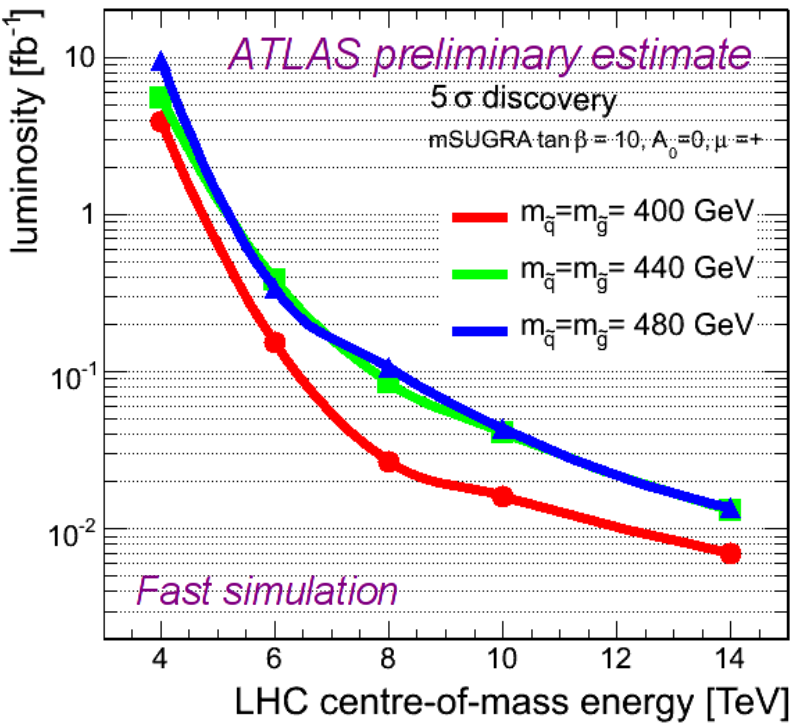
|
| Signal significance possible for the decay of a Standard Model Higgs to W pairs, summing both gluon-fusion and vector-boson fusion channels. Only leptonic W decays are used. Significance is shown as a function of centre-of-mass energy for 1 fb-1 of well-understood data. Other channels (H to ZZ and H to two photons) will also contribute, but are not included. Mixed fast and full (GEANT4) simulation study for the mixed electron/muon W decays using a cut-based approach, with a simple scale factor sqrt(2) applied on the signal significance to account for the double-electron and double-muon decay channels. Five sigma discovery sensitivity opens up with 1 fb-1 and a centre-of-mass energy of close to 10 TeV, for the most favourable Higgs masses (160-170 GeV). |
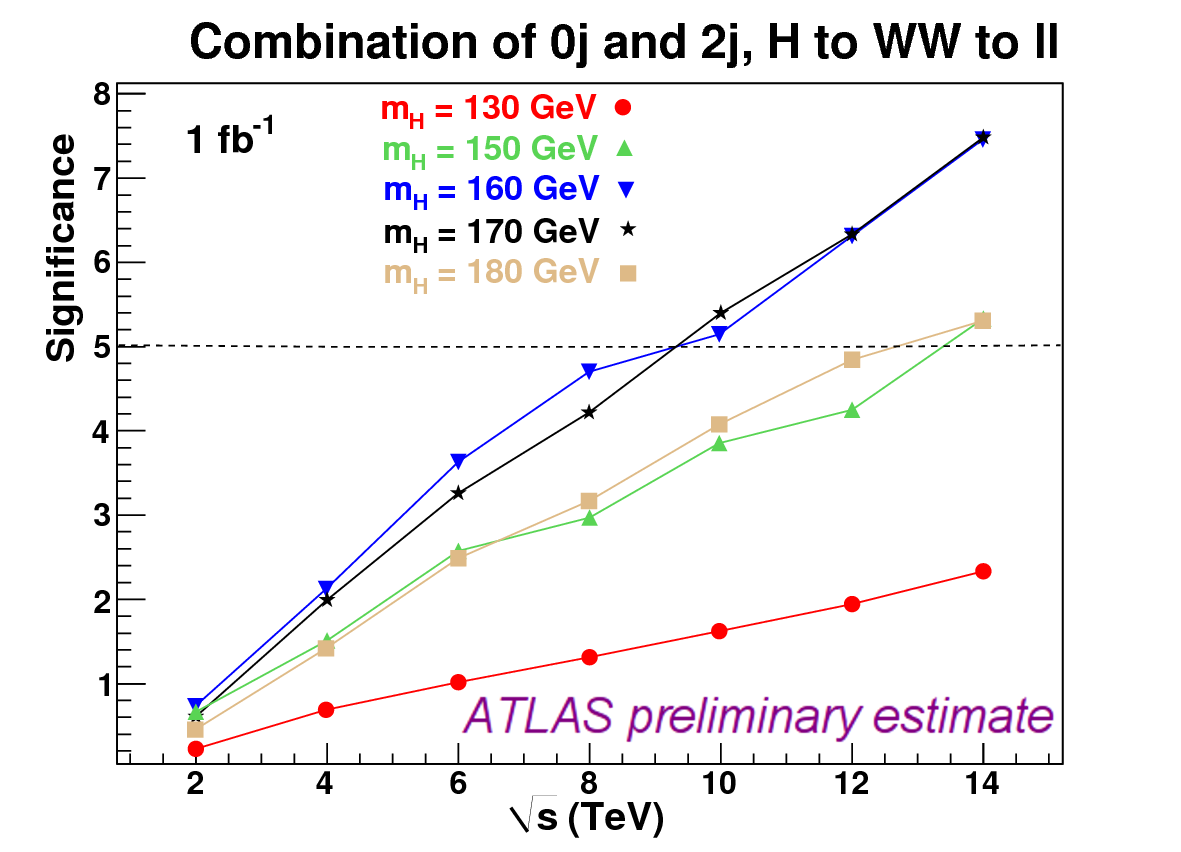
|
| Integrated luminosity needed, as a function of centre-of-mass energy, to approach the reach of a single Tevatron experiment with 8 fb-1 of data, for a Standard Model Higgs mass of 160 GeV. This Tevatron experiment sensitivity was estimated in December 2008, and improvements in Tevatron analyses will tend to make it pessimistic. For the ATLAS estimate only the gluon-fusion Higgs production channel, and leptonic W decays, are considered. The overall sensitivity is approximately 1.9 sigma. Full (GEANT4) simulation study for the mixed electron/muon W decays, using a cut-based approach, with a simple scale factor 2 applied on the signal and background yields to account for the double-electron and double-muon decay channels. Systematic errors have not been re-evaluated from the studies done in the CSC book. The overall luminosity scale uncertainty is significant, perhaps +-50%. With 200 pb-1 of 10 TeV data, it should be possible to approach the Tevatron sensitivity for this Higgs mass, assuming the systematic uncertainty on the knowledge of the backgrounds would remain under control. Note that the Tevatron analyses have been updated since this plot was made. |
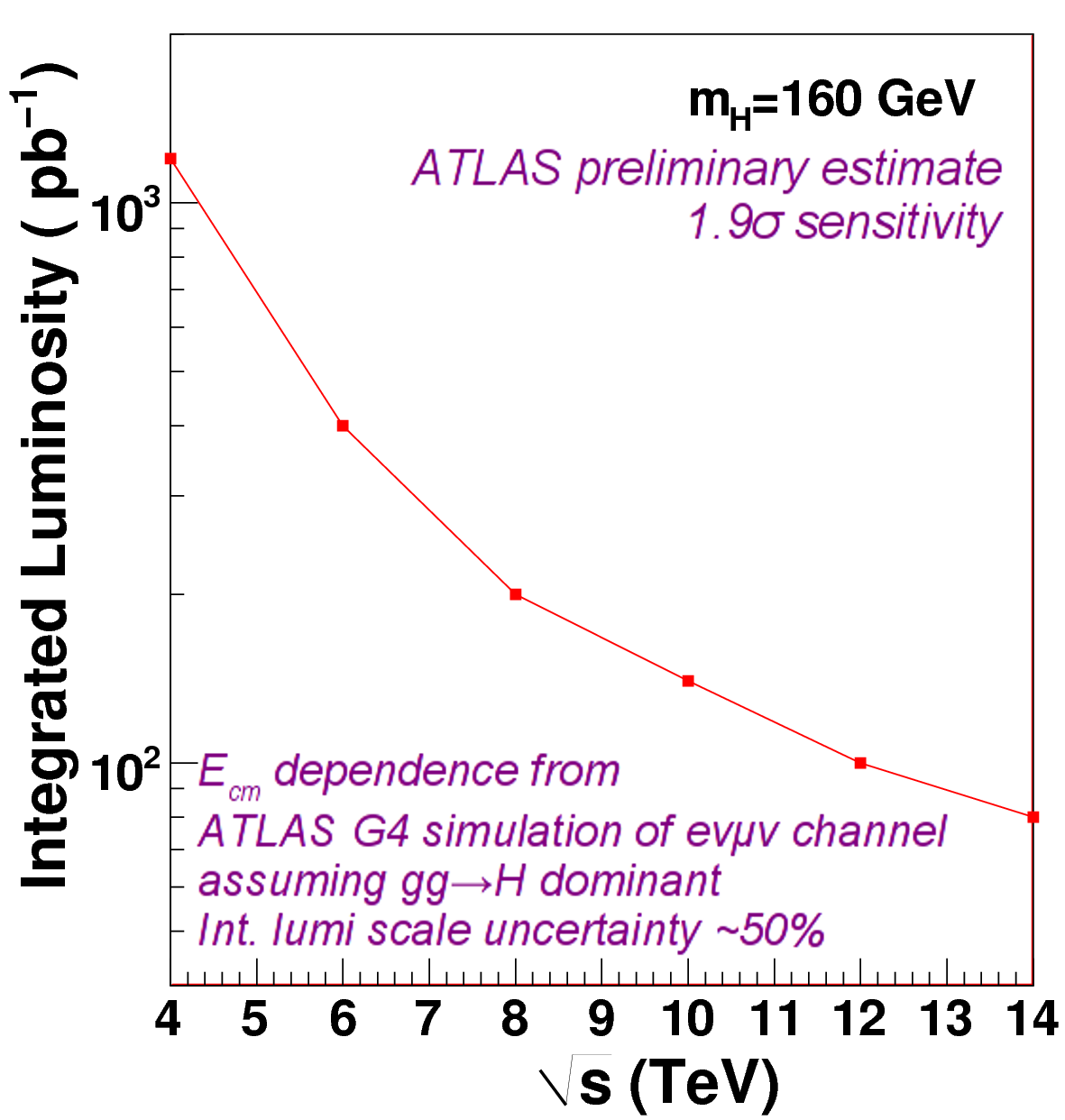
|
Further information, links
Responsible: Dave Charlton
Last reviewed by:
Topic revision: r30 - 2010-12-06 - ElmarRitsch
or Ideas, requests, problems regarding TWiki? use Discourse or Send feedback


